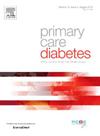2型糖尿病患者血糖和体重控制:一项现实世界初级保健观察性研究
IF 2.6
4区 医学
Q3 ENDOCRINOLOGY & METABOLISM
引用次数: 0
摘要
目的:分析2型糖尿病(T2DM)患者的血糖和体重控制,以及初级保健的处方模式。方法:我们回顾了5009名随机选择的T2DM患者的电子病历,这些患者来自西班牙70个卫生中心。我们按年龄组和有无肥胖来分析结果。所有数据于2022年收集。结果:在治疗方面,13.2 %的样本只接受生活方式治疗,76.5 %的样本接受二甲双胍、37.6% %的SGLT2抑制剂、32.2% %的DPP-4抑制剂、12.2 %的GLP-1激动剂、18.9% %的胰岛素、6.5 %的磺脲类药物和1.3 %的格列酮。57.7% %的患者糖化血红蛋白(HbA1c)低于7 %,62.3% %的患者达到个体化HbA1c目标。总体而言,42% %的人口肥胖(女性为45.6% %,男性为39.1% %; = 0.001页)。无论男女,肥胖率都随着年龄的增长而下降。我们发现肥胖和血糖控制不良(hba1)之间没有关联。结论:2022年,西班牙家庭医生治疗的2型糖尿病患者中,超过60% %达到了他们的个体化血糖控制目标,但只有三分之一的人血糖控制良好,没有肥胖。在我们的研究中,对心肾有益的药物(尤其是SGLT2抑制剂)的使用高于之前发表的数据。本文章由计算机程序翻译,如有差异,请以英文原文为准。
Glycemic and weight control in people with type 2 diabetes: A real-world observational study in primary care
Aims
To analyze glycemic and bodyweight control in people with type 2 diabetes mellitus (T2DM), and prescribing patterns in primary care.
Methods
We reviewed the electronic medical records of 5009 randomly selected T2DM patients, from 70 health centers in Spain. We analyzed results by age group and presence/absence of obesity. All data were collected in 2022.
Results
Regarding treatment, 13.2 % of the sample were on lifestyle therapy only, 76.5 % received metformin, 37.6 % SGLT2 inhibitors, 32.2 % DPP-4 inhibitors, 12.2 % GLP-1 agonists, 18.9 % insulin, 6.5 % sulfonylureas, and 1.3 % glitazones. Glycated Hemoglobin (HbA1c) was below 7 % in 57.7 % of patients, and 62.3 % met their individualized HbA1c targets. Overall, 42 % of the population was obese (45.6 % of women vs 39.1 % of men; p = 0.001). Obesity rates decreased with age in both sexes. We found no association between obesity and poor glycemic control (HbA1c<7 %) (43,5 % vs 41,4 %; p = 0,17).
Conclusions
In 2022, over 60 % of people with T2DM treated by family doctors in Spain met their individualized glycemic control targets, but only one in three had good glycemic control without obesity. The use of drugs with cardiorenal benefits (particularly SGLT2 inhibitors) is higher than previous published data in our setting.
求助全文
通过发布文献求助,成功后即可免费获取论文全文。
去求助
来源期刊

Primary Care Diabetes
ENDOCRINOLOGY & METABOLISM-PRIMARY HEALTH CARE
CiteScore
5.00
自引率
3.40%
发文量
134
审稿时长
47 days
期刊介绍:
The journal publishes original research articles and high quality reviews in the fields of clinical care, diabetes education, nutrition, health services, psychosocial research and epidemiology and other areas as far as is relevant for diabetology in a primary-care setting. The purpose of the journal is to encourage interdisciplinary research and discussion between all those who are involved in primary diabetes care on an international level. The Journal also publishes news and articles concerning the policies and activities of Primary Care Diabetes Europe and reflects the society''s aim of improving the care for people with diabetes mellitus within the primary-care setting.
 求助内容:
求助内容: 应助结果提醒方式:
应助结果提醒方式:


